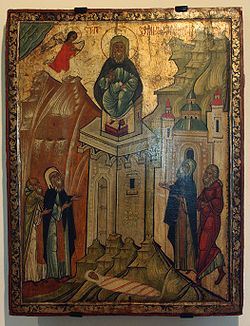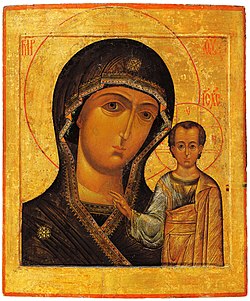Top Qs
Timeline
Chat
Perspective
September 1 (Eastern Orthodox liturgics)
From Wikipedia, the free encyclopedia
Remove ads
Aug. 31 - Eastern Orthodox liturgical calendar - Sep. 2

All fixed commemorations below celebrated on September 14 by Orthodox Churches on the Old Calendar.[note 1]
For September 1st, Orthodox Churches on the Old Calendar commemorate the Saints listed on August 19.
Feasts
Saints
- Righteous Joshua, the son of Nun (c. 16th century BC)[12][13][note 6]
- Martyrs Callista and her brothers Evodos and Hermogenes at Nicomedia (309)[15][16]
- Holy 40 virgin-martyrs and their teacher the Hieromartyr Ammon the Deacon at Heraclea in Thrace (321-323):[17][18][note 7]
- Laurencia the deaconess; Celsina; Theoclia; Theoctista; Dorothy; Eutychia; Thecla; Aristaineta; Philadelphia; Mary; Veronica; Euthymia; Lamprotatia; Euphymia; Theodora; Theodota; Teteia; Aquilina; Theodulia; Aplodora; Lampadia; Procopia; Paula; Junilla; Ampliana; Percissa; Polynicia; Maura; Gregoria; Kyriake; Bassa; Callinica; Barbara; Cyriena; Agathonica; Justa; Irene; Timothea; Tatiana; and Anna.[19]
- Martyr Aeithalas the Deacon of Persia (380)[20]
- Venerable Martha, the mother of St Simeon Stylites (428)[21][22]
- Venerable Simeon Stylites the Elder (459)[23][24][note 8]
- Venerable Evanthia.[25]
- Saint Dionysius Exiguus, inventor of the Anno Domini (AD) era (c. 544)[26][27][note 9]
- Saint Symeon Stylites of Lesbos (c. 845)[29][note 10]
Remove ads
Pre-Schism Western saints
- Hieromartyr Priscus of Capua, first Bishop of Capua in Italy, where he was sent by the Apostle Peter, and martyred under Nero by tradition (c. 66)[31][note 11]
- Hieromartyr Terentian, Bishop of Todi in Umbria in Italy, under Hadrian (118)[31][note 12]
- Virgin-martyr Vibiana, in Rome, whose relics are now venerated in Los Angeles, of which she is the main patron-saint (3rd century)[31]
- Saint Sixtus of Reims, first Bishop of Rheims in France (c. 300)[31][note 13]
- Hieromartyr Firminus of Amiens, third Bishop of Amiens in France (c. 303)[31]
- The 12 Holy Brothers, Martyrs, who suffered in the south of Italy and were brought together and enshrined at Benevento in 760 (c. 303):[31]
- Saint Verena of Zurzach (Switzerland) (c. 350)[14][31][32][note 15]
- Saint Victorius (Victurius), a disciple of St. Martin of Tours who became Bishop of Le Mans in France in c. 453 (c. 490)[14][31]
- Saint Constantius of Aquino, Bishop of Aquino in Italy (c. 520)[31][note 16]
- Saint Regulus (San Regolo), exiled from North Africa by the Arian Vandals, he landed in Tuscany in Italy and was martyred under Totila (545)[31][note 17]
- Saint Lupus of Sens, a monk at Lérins who became Bishop of Sens in France in 609 (623)[31][note 18]
- Saint Nivard of Rheims, Archbishop of Rheims in France (673)[31]
- Saint Giles of Nîmes (Aegidius), monastic founder along the Rhone (c. 712)[19][32][note 19]
- Saint Lythan (Llythaothaw), a saint in Wales to whom two churches are dedicated.[31]
- Saints Giles (Aegidius) and Arcanus, founded a monastery that later grew into Borgo San Sepulcro in central Italy (1050)[31]
Post-Schism Orthodox saints
- Saint Meletius the Younger, of Thebes (1105)[19][33][34][note 20]
- Venerable Nicholas of Courtaliatis in Crete, monk (1670)[19][35]
- New-Martyr Angelis of Constantinople (1680)[19][36]
- Venerable Anthony of Agyia.[37]
- Saint Haido of Stanos (1820-1821)[32]
New Martys and Confessors
- Virgin-martyrs Tatiana Gribkov and Natalia Kozlov (1937)[38]
Other commemorations
- Commemoration of the Great Fire of Constantinople (c. 470)[39]
- Synaxis of the Most-Holy Theotokos of Miasena Monastery, in memory of the finding of her icon (864)[40][41]
- Celebration of the first miracle of the Icon of the Theotokos (Eletskaya) at Chernigov-Gethsemane (Chernihiv-Hefsemanska) (1869)[42][43][note 21]
- Celebration of the "All-Blessed" or "Pamakarista" Icon (11th century) of Our Lady of Kazan (1905)[44][note 22]
Remove ads
Icon gallery
- Icon of Jesus of Navi (Joshua).
- Righteous Joshua, the son of Nun. Fresco from Hosios Loukas monastery in Boeotia, Greece.
- St. Simeon Stylites. Second half of the 16th century, Kostarowce, Historic Museum in Sanok, Poland.
- Saint Vibiana, 19th century
- Icon of Our Lady of Kazan.
Notes
- The notation Old Style or (OS) is sometimes used to indicate a date in the Julian Calendar (which is used by churches on the "Old Calendar").
The notation New Style or (NS), indicates a date in the Revised Julian calendar (which is used by churches on the "New Calendar"). - KONDAK OF THE INDICTION, TONE 2:
"O Christ, the King Who dwells on high, the Creator and Fashioner of everything visible and invisible, You, Who order the days and nights, times and seasons, Bless now the crown of the year, guarding and protecting Your city and people in peace, O Most Merciful One."[4] - Since 1989, every September 1st (the beginning of the ecclesiastical calendar) has been designated as a day of prayer for "the protection of the environment" throughout the Eastern Orthodox Church. Instituted by Patriarch Dimitrios of the Greek Orthodox Church in 1989, the tradition has since been shepherded by his successor Patriarch Bartholomew I of Constantinople who has been dubbed "The Green Patriarch."[5]
- "...Accordingly, we declare the first day of September of each year a day on which, on the feast of the Indiction, namely the first day of the ecclesiastical year, prayers and supplications are to be offered in this holy center of Orthodoxy for all creation, declaring this day to be the day of the protection of the environment."[6]
- Ecumenical Patriarchate: (in Greek) Πατριαρχική καί Ἀρχιερατική Χοροστασία. -- "Ἡ ἡμέρα αὐτή τῆς ἀρχῆς τῆς Ἰνδίκτου ἀφιεροῦται εἰς τήν προστασίαν τοῦ φυσικοῦ περιβάλλοντος. Ὁ ἑορτασμός ἐθεσπίσθη κατά τήν Συνεδρίαν τῆς Ἁγίας καί Ἱερᾶς Συνόδου τῇ 6ῃ Ἰουνίου 1989."[7]
- In July 2015, the Holy Synod of the Russian Orthodox Church also established a day of special prayer for God’s creation at its meeting on July 13, 2015, in St. Petersburg (Minutes no. 41), deciding to establish the day of special prayer on the first Sunday of September.[8] It stated that September 1 – the date fixed by the heads of Local Orthodox Churches at their meeting of 2008 – would be inconvenient, as there would an overlapping of other services at the beginning of the academic year.[8]
- In August 2015, The Vatican also announced a "World Day of Prayer for the Care of Creation",[9] to be celebrated annually on September 1, in line with the Orthodox Church’s day for the protection of the environment.[10][11]
- He was born in Scythia, in modern-day Romania. He moved to Rome at the end of the 5th century and translated a number of lives and works of the saints into Latin, as well as collections of Church canons. He also compiled tables for calculating the date of Pascha and introduced the practice of dating from the Nativity of Christ.[28]
- Commemorated together with his brothers David and George of Mytilene on February 1.[30]
- An Egyptian related to a soldier of the Theban Legion, she travelled to Switzerland in search of him and settled as an anchoress near Zurich.
- Meletius the New of the Mountain of Myoupolis.
- See: (in Russian): ИЛЬИНСКАЯ ЧЕРНИГОВСКАЯ ИКОНА БОЖИЕЙ МАТЕРИ. Православная Энциклопедия. Russian Orthodox Encyclopedia.
- In 1905, Patriarch Joachim III presented a copy of the icon to the city of Kazan in Russia.
Remove ads
References
Sources
Wikiwand - on
Seamless Wikipedia browsing. On steroids.
Remove ads





